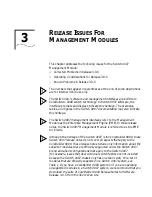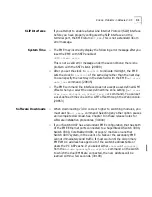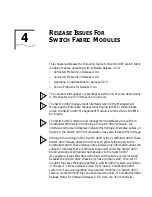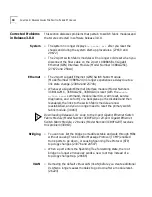
20
C
HAPTER
2: R
ELEASE
H
IGHLIGHTS
Sample
Configurations and
System Behavior
This section describes how the system behaves in certain feature
configurations. Refer to Table 3 when reading the corresponding
paragraphs below.
Configuration A
Ports autonegotiate connections according to the IEEE 802.3u
specification. Error conditions are not monitored. No alerts are sent and
preventive actions are not taken. If the remote port (the port to which the
switch is connected) is fixed in full duplex mode or uses a non-compliant
version of autonegotiation, duplex mismatches are likely to occur, causing
problems for the link, switch, and portions of the network that rely on
that switch. However, if standard autonegotiation is enabled on the
switch and the remote port, the speed and duplex modes will be set
correctly.
Configuration B
Ports autonegotiate connections according to the IEEE 802.3u
specification. The system monitors specified ports for errors and sends
alerts through traps and console messages. If the remote port is fixed in
full duplex mode or uses a non-compliant version of autonegotiation,
duplex mismatches are possible. However, the Port Monitoring feature
can partition ports with high error rates (which, incidentally, may also be
caused by factors other than duplex mismatches such as damaged
cabling).
The error threshold is fixed in system software; it is not user-configurable.
The initial time period in which a port is partitioned (disabled) is 30
seconds. When the system reenables the port, it also immediately
monitors the error conditions. If the error threshold is reached again, the
port is partitioned again. The time that the port is partitioned increases
with each incidence, up to a maximum of 5 minutes.
Table 3
Sample Configurations
Standard
Autonegotiation
Enabled
Port
Monitoring
Enabled
Advanced
Autonegotiation
Enabled
Configuration A
Yes
No
No
Configuration B
Yes
Yes
No
Configuration C
Yes
No
Yes
Configuration D
No
Yes
No
Configuration E
No
No
Yes
Summary of Contents for 4007
Page 10: ......
Page 32: ...32 CHAPTER 3 RELEASE ISSUES FOR MANAGEMENT MODULES...
Page 64: ...64 CHAPTER 5 RELEASE ISSUES FOR LAYER 2 SWITCHING MODULES...
Page 128: ......
















































